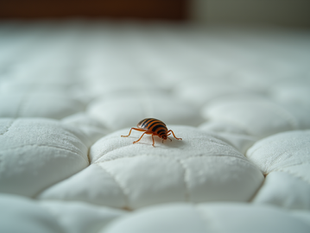
How to Spot the Signs of a Bed Bug Infestation
0
2
0
Bed bugs are tiny pests that can cause big problems in your home. They are experts at hiding and can multiply quickly if not detected early. Knowing how to spot the signs of a bed bug infestation is crucial to stopping them before they spread. This guide will help you identify the key bed bug signs and take action to protect your living space.
Recognizing Common Bed Bug Signs
Bed bugs are small, reddish-brown insects about the size of an apple seed. They feed on human blood, usually at night, and leave behind several telltale signs. Here are the most common indicators that bed bugs may be present:
Bite marks on your skin: These often appear as small, red, itchy bumps, usually in a line or cluster. They can be mistaken for mosquito bites but tend to be more persistent.
Blood stains on sheets or pillowcases: After feeding, bed bugs may leave tiny blood spots where they were crushed.
Dark or rusty spots on mattresses and furniture: These are bed bug excrement and can be found near their hiding places.
Shed skins and eggshells: Bed bugs molt as they grow, leaving behind translucent skins and tiny white eggs.
A musty, sweet odor: In heavy infestations, a distinct smell similar to coriander or almonds may be noticeable.
Inspect areas where bed bugs like to hide, such as mattress seams, bed frames, headboards, and nearby furniture. Use a flashlight and magnifying glass for a closer look.

Detailed Bed Bug Signs in Different Areas of Your Home
Bed bugs are skilled at hiding in cracks and crevices. Knowing where to look can help you catch an infestation early.
Bedroom
The bedroom is the most common place to find bed bugs. Check:
Mattress seams and tags
Box springs and bed frames
Headboards and nightstands
Underneath pillows and sheets
Look for live bugs, shed skins, and fecal spots. Pay special attention to the corners and folds of bedding.
Living Room
Bed bugs can also hide in living rooms, especially if you have upholstered furniture. Inspect:
Sofa cushions and seams
Recliners and chairs
Behind baseboards and electrical outlets
Under rugs and carpets near seating areas
Luggage and Clothing
Bed bugs often hitchhike on luggage and clothing. After traveling, inspect your bags and wash clothes in hot water immediately.
Other Hiding Spots
Wall cracks and crevices
Picture frames and wall hangings
Electrical outlets and switch plates
Behind wallpaper and loose paint
Regularly checking these areas can help you detect bed bugs before they spread.

How much to test for bed bugs?
Testing for bed bugs can vary in cost depending on the method and extent of inspection. Professional inspections typically range from $100 to $500, depending on the size of the property and severity of the infestation. Some companies offer free or low-cost initial inspections.
DIY methods include using bed bug interceptors placed under bed legs or visual inspections, which are free but less reliable. For accurate detection, especially in early stages, professional canine bed bug detection is highly effective. Dogs trained to sniff out bed bugs can identify infestations quickly and with high accuracy.
If you suspect an infestation but are unsure, consider contacting a bed bug inspection service to get a thorough and professional evaluation.

What to Do If You Spot Bed Bug Signs
If you find any signs of bed bugs, act quickly to prevent the infestation from worsening.
Confirm the infestation: Use a magnifying glass or take photos to document the evidence.
Clean and declutter: Remove clutter where bed bugs can hide. Wash bedding, curtains, and clothing in hot water and dry on high heat.
Vacuum thoroughly: Vacuum mattresses, furniture, floors, and cracks. Dispose of the vacuum bag immediately in a sealed plastic bag.
Encase mattresses and pillows: Use bed bug-proof covers to trap any remaining bugs and prevent new ones from entering.
Contact professionals: Bed bugs are difficult to eliminate without expert help. A professional pest control company or a specialized bed bug inspection service can provide treatment options.
Avoid using DIY chemical sprays without guidance, as improper use can worsen the problem or pose health risks.
Preventing Future Bed Bug Infestations
Prevention is key to avoiding the stress and expense of dealing with bed bugs. Here are some practical tips:
Inspect secondhand furniture before bringing it into your home.
Use protective covers on mattresses and box springs.
Reduce clutter to minimize hiding spots.
Be cautious when traveling: Inspect hotel rooms, keep luggage off the floor, and wash clothes immediately upon return.
Regularly inspect your home for early signs of bed bugs.
By staying vigilant and taking preventive measures, you can protect your home from these persistent pests.
Spotting bed bug signs early can save you time, money, and discomfort. Regular inspections and prompt action are your best defense against an infestation. If you suspect bed bugs, don't hesitate to reach out to a trusted bed bug inspection service for professional help. Your peace of mind and a bug-free home are worth it.






